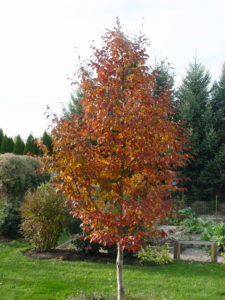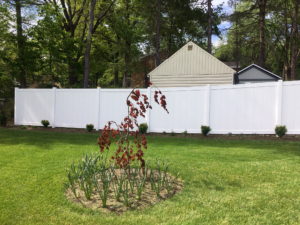I’ll Take the Smaller One, Please
September 29th, 2020
I’ve planted 11 trees at my new place in the last year and a half, and in every case, I bought small ones.
Small as in ones in the four- to six-foot-tall range as opposed to the bigger ones that many nurseries also offer.
I mention this because it’s a question I often get – “Which size tree should I buy?”
Nurseries and garden centers will tell you that tree shoppers often ask for the biggest and fastest-growing trees, saying something like, “I’ll be dead before I see a little one amount to anything.”
Fast-growers might throw out more shade than average- and slow-growers, but they also too often keep going to the point where they outgrow the space. And they do so at the expense of more brittle and less dense wood in exchange for the speedy growth.
Unfortunately, you can’t hit a pause or stop button on those fast-growers once the size is just right.
As for the size at buying time, numerous studies have found that smaller trees establish faster and usually match or surpass the size of the larger one, sometimes in as little as three years, according to a 2016 study at Texas A&M University.
That’s because large trees are generally field-grown ones that lose one-third to nearly one-half of their root systems when being dug and wrapped in burlap for transport.
Those trees tend to lag in growth until their root systems recover enough for the tree to invest energy in producing more and longer branches and more water-hungry foliage. They need to fortify their roots first.
Smaller ball-and-burlap trees have more of their root system intact, and container-grown ones have all of their roots.
For my money, I’ll take a tree any day that has a hefty root system in relation to the tree size vs. one with a lot of tree and not much of a rootball to support it.
Smaller trees offer a few more advantages. They’re easier to handle, they don’t need gigantic planting holes, they need less water after planting, they usually don’t need staking, and they suffer less transplant shock, meaning a higher survival rate.
One of the biggest pluses for me is price. Smaller trees cost way less than their bigger brothers.
That’s because nurseries have invested a few more years of growing care into the big guys (fertilizer, water, pruning, etc.) and invest more in digging and moving them – not to mention covering the higher cost of loss if/when they fail.
I paid mostly in the $59-$99 range for my four- to six-footers. For the same species that were just a few feet taller, the cost was three to four times higher.

This Japanese umbrella pine carries a $500 price tag. I bought my little one for under $40 and will be patient.
I came away with sticker shock when browsing some of the bigger stock. Even common red maples and honeylocusts were $200-$250, while larger sizes of slow-growers such as cutleaf Japanese maples and Japanese umbrella pine (even just six-footers) were selling for $500.
It’s a lesson in the value of patience. To save $100, $200, or more per tree, I can be patient,
Besides, I like to watch trees grow. I enjoy the blooms and the fall color as much in smaller packages as in big ones. And raising youngsters gives me the chance to shape and train my trees.
My favorite example of that was about 25 years ago when I was looking for a Korean stewartia, a beautiful small tree that blooms white in summer and has a fantastic blend of bright fall foliage and Dalmatian-like flaking bark.
I found one at season’s end at Highland Gardens – a sad-looking little three-foot specimen that had a double leader (forked trunk). Nobody wanted it. It was marked down to 50-percent off. I got it for less than $30.

My bargain Korean stewartia started out as a forked two-footer that nobody wanted to this sleek and straight beauty.
I planted it in good soil, pruned off the weaker fork, and it grew into a beautiful, straight tree that was 12 feet tall and counting when I moved.
Another example was the three-gallon, two-foot-tall Japanese umbrella pine I bought about a dozen years ago at Ashcombe’s. I paid under $40 for it and patiently watched it grow to nearly eight feet tall before moving. Judging by retail prices, it’d be worth nearly $700 today.
Now, there are a few reasons to consider bigger trees… assuming you’re OK with the higher price.
One is that bigger trees give more immediate impact and a little more immediate shade.
They’re also not as threatened by deer, which seem to like just about anything that’s young and tender.
Even if deer eat the lower branches of a bigger tree, the tree can survive on the higher foliage that these furry plant destroyers can’t reach. (Bucks can still kill larger trees from bark damage when they rub their antlers on trunks.)
Field-grown, balled-and-burlapped trees also (usually) come without the circling roots that are common in container-grown trees.
It’s very important to free and fray out matted or circling roots on any plant so they head out into the surrounding ground instead of staying in a trunk-choking ball.
On the other hand, balled-and-burlapped trees often have excess soil atop the ball, which makes them more prone to dying from too-deep planting if you go by the soil line and not the root flare (where the trunk starts to widen out as it transforms into the root system).
See George’s post on “So You Think You Know How to Plant a Tree?”
All in all, I like the risk profile of smaller trees better… to a point. Although I’ve had decent luck with my own cuttings and with tree and shrub trial plants growing in as little as one-gallon pots, the really little stuff has very small root systems that make the plant more vulnerable to things like dry soil, weather extremes, and animal-pest damage.
Somewhere in the middle has worked best for me. When it comes to trees, a six-footer is just about perfect.
See George’s list of top 10 shade trees
See George’s list of top 10 small trees
See George’s list of 12 mid-size trees to replace those dying ashes
See George’s list of top 10 native trees for home landscapes
See George’s list of bottom 10 trees
See George’s list of 10 trees with peeling or flaking bark
See George’s list of 12 of the best needled evergreen trees








